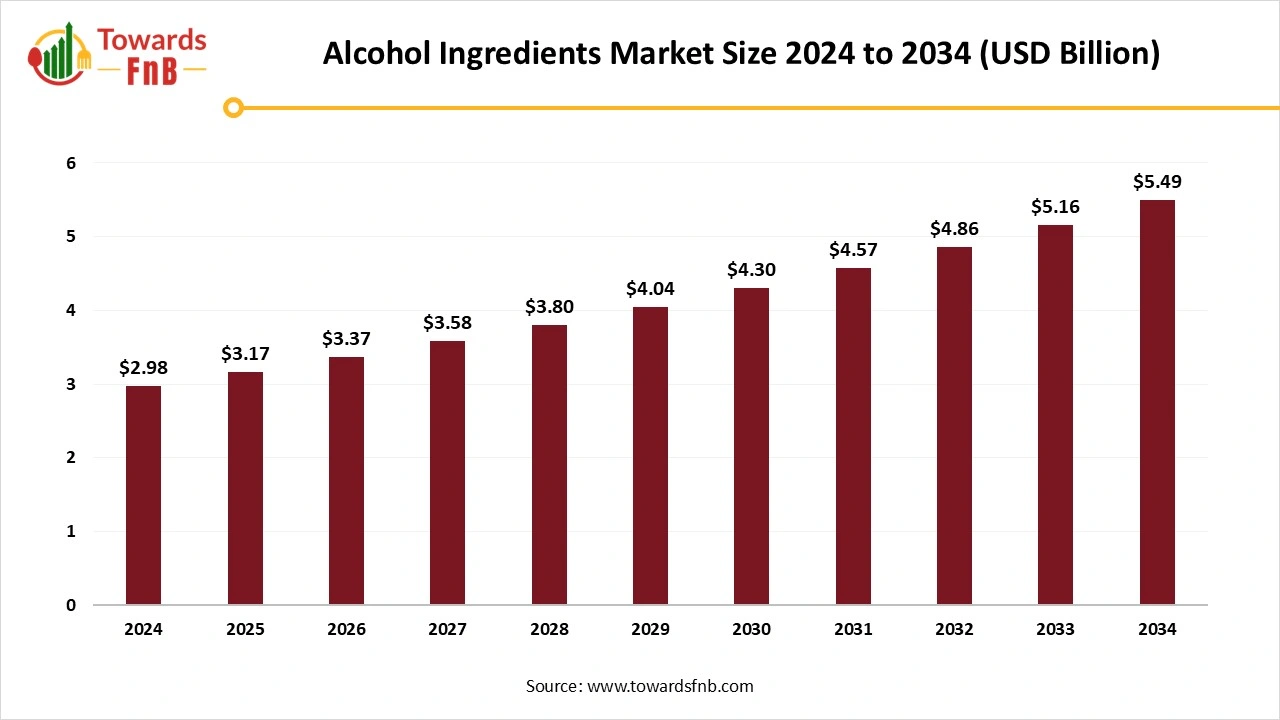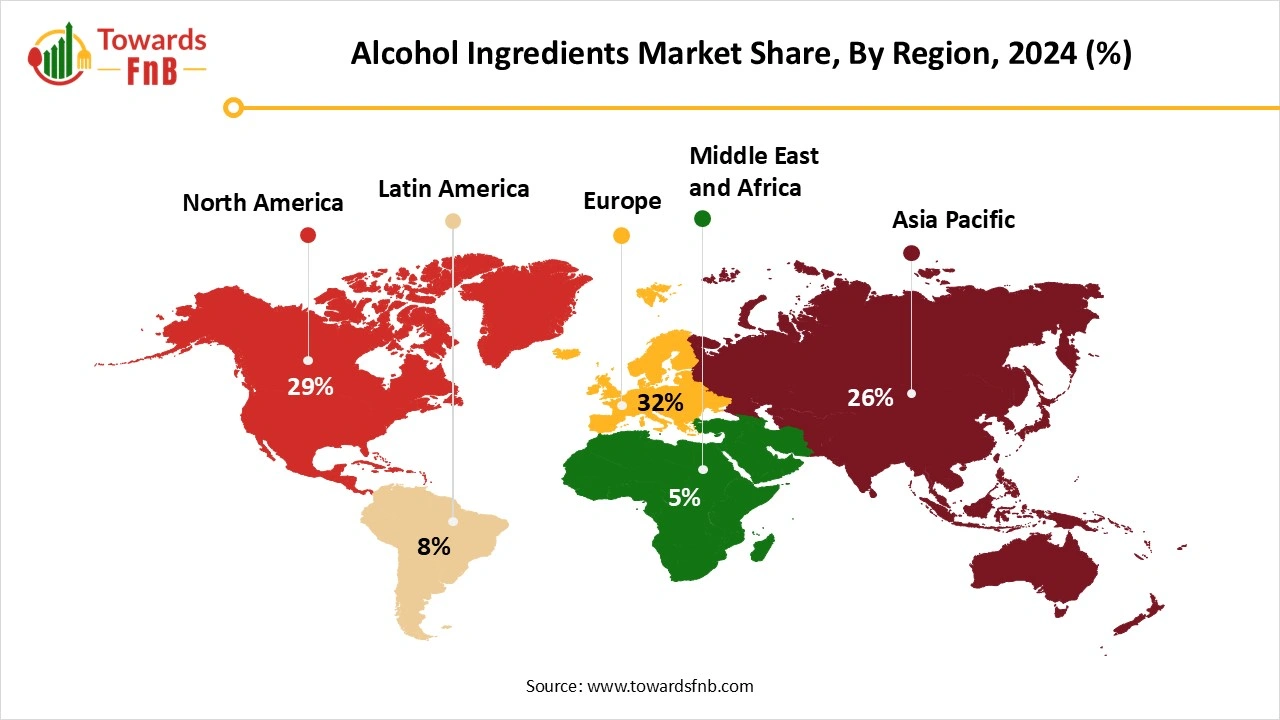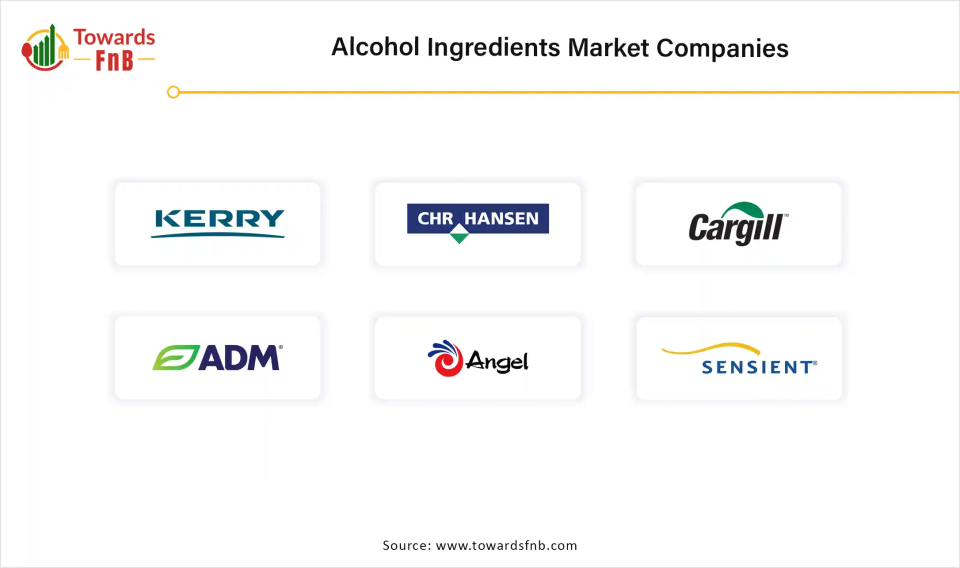December 2025
The global alcohol ingredients market size was estimated at USD 2.98 billion in 2024 and is expected to rise from USD 3.17 billion in 2025 to nearly reaching USD 5.49 billion by 2034, growing at a CAGR of 6.3% during the forecast period from 2025 to 2034. Growing demand for premium and craft beer and changing consumer taste and preferences driving the market.

| Study Coverage | Details |
| Growth Rate from 2025 to 2034 | CAGR of 6.3% |
| Market Size in 2025 | USD 3.17 Billion |
| Market Size in 2026 | USD 3.37 Billion |
| Market Size by 2034 | USD 5.49 Billion |
| Largest Market | Europe |
| Base Year | 2024 |
| Forecast Period | 2025 to 2034 |
| Regions Covered | North America, Europe, Asia-Pacific, Latin America, and Middle East & Africa |
The alcohol ingredients market refers to the global industry focused on the production, supply, and commercialization of raw materials and additives used in the manufacturing of alcoholic beverages. These ingredients include fermentable sugars, enzymes, flavors, colorants, and preservatives, and are essential to produce beer, spirits, wine, ciders, and ready-to-drink (RTD) alcohol products. The market includes both natural and synthetic ingredients, targeting beverage quality, taste differentiation, shelf-life, and regulatory compliance.
Modern consumers are actively looking for distinctive, daring, and culturally rich flavors that surpass conventional selections. The alcohol sector is exploring new flavor varieties to broaden its customer reach. To attract consumers looking for high-quality drinks, brands are moving past classic citrus and berry components, leveraging the possibilities of exotic fruits from around the world in their alcoholic products, such as mango, papaya, or dragon fruit inspired by Asian flavors.
Artisanal cocktails, flavored liquors, and infused brews have entered the mainstream, enabling companies to explore flavor, texture, and presentation. These taste-driven innovations act as a vital differentiator in a saturated market. They enhance consumer interaction and facilitate premium pricing, brand loyalty, and international growth into various taste segments.
A significant issue in the alcohol ingredients market is the rigorous regulatory environment that oversees the production, labeling, and advertising of alcoholic drinks. Government agencies and regulatory organizations enforce strict compliance standards for safety, quality, and ingredients, complicating the ability of manufacturers to launch new formulations and enter international markets. These regulations differ by region, necessitating that companies engage in thorough testing, certification, and compliance processes, leading to heightened production costs and postponed product launches.
Europe Dominated the Alcohol Ingredients Market in 2024.
The rising trend of premium beverages acts as a key driver for the growth of the market in Europe. As consumer demand grows for high-quality, artisanal, and craft drinks among various demographic segments, beverage producers are proactively pursuing innovative, premium ingredient options. Increasing consumer interest in natural, transparent, and clean label products fosters the necessity for ongoing investment in ingredient development, sustainable sourcing, and formulations that prioritize consumer needs.
This transition demands significant financial and intellectual investments from ingredient producers, beverage manufacturers, and food technology businesses. In 2019, 8.4% of the adult population in the EU drank alcohol every day, 28.8% did so weekly, 22.8% monthly, and 26.2% never drank. In the area, men consume almost four times as much alcohol as women, with recent statistics indicating that there are 470 million drinkers. Such growing population of people consuming the alcohol further driving the market.

Increasing popularity of high-quality and artisanal alcoholic drinks significantly influence Germany's market. Consumers are displaying a preference for handcrafted and premium products that provide distinctive tastes and brand narratives. This trend is prominently seen in the categories of beer and spirits, where small-batch distilleries and microbreweries are gaining popularity. Premiumization demonstrates a readiness to spend extra for perceived worth, genuine quality, and uniqueness. It is backed by rising disposable income and a developed palate among German consumers.
Asia Pacific Expects Significant Growth During the Forecast Period.
The significant population of the Asia Pacific region and the growing acceptance of social venues like bars and pubs are contributing to the increase in alcohol consumption. The increasing trend of drinking among the youth is also a major factor driving the alcohol ingredients market. Moreover, an increase in disposable income and economic progress in developing nations like China, India, and South Korea drives market expansion. The World Health Organization reports that China ranks among the top alcohol consumers, projecting a rise in per capita consumption of 0.9 liters of pure alcohol by 2025 compared to 2016.
The need for artisanal and high-quality alcoholic drinks in India is significantly increasing and expanding the market. As urbanization grows and disposable incomes elevate, individuals are becoming bolder in their choices of alcoholic drinks. Younger generations, particularly millennials and Gen Z, are choosing high-quality, specialty beverages such as craft beer, premium wine, and artisanal spirits. In this regard, consumers seek products that offer practical advantages, such as natural components or extra vitamins and antioxidants, as part of the broader wellness trend.
Which Ingredient Type Segment Dominated the Alcohol Ingredients Market in 2024?
Yeast segment led the alcohol ingredients market in 2024. Yeast plays an essential role in creating different kinds of alcoholic drinks, with fermentation serving as a key phase in brewing. The growth of craft brewing not only improves consumer options but also encourages a culture of innovation and excellence, subsequently boosting the need for premium yeast in the brewing sector. Yeast is crucial in the manufacturing of all alcoholic drinks, and choosing appropriate yeast strains is important not just for optimizing alcohol production but also for preserving the sensory quality of the beverage.
Flavors and Salts Segment is Observed to Grow at the Fastest Rate During the Forecast Period.
The growing interest in distinctive and rare tastes in alcoholic drinks, including craft beers and specialty cocktails, has greatly enhanced the market. The increasing inclination towards global cuisines, the accessibility of a wide range of international alcoholic brands, and the rising desire for natural flavors and no preservatives all drive the growth of the flavored alcohol market. Ongoing advancement in flavor creation, incorporating natural and unique ingredients, additionally drives the expansion of the flavor sector.
Why Beer Segment Held the Dominating Share of the Alcohol Ingredients Market in 2024?
Beer segment held the dominating share of the alcohol ingredients market in 2024. The market is being transformed by changing consumer preferences, as premium products and health-focused choices are becoming more popular among urban populations. Young consumers favor craft beer because it provides a range of styles and flavor profiles. Craft beer is gaining more popularity. Craft breweries are recognized for their regular trials with various ingredients to create a unique taste.
Ready-to-Drink (RTD) Alcoholic Beverages Segment is Seen to Grow at a Notable Rate During the Predicted Timeframe.
An increasing number of consumers are choosing convenient food and drink choices because of hectic lifestyles. RTD alcoholic drinks offer convenience by being pre-mixed and ready to drink, removing the need for consumers to mix their own beverages. In recent times, there has been a significant change in consumer preferences, with a greater inclination towards simplicity and convenience. RTD drinks address this persistent trend by providing a convenient drinking experience without sacrificing flavor.
Which Source Segment Dominated Alcohol Ingredients Market in 2024?
Natural (grain-based) segment dominated the market with the largest share in 2024. Cereals like corn, barley, and rye are frequently utilized in alcohol production. Ethanol, sourced from cereals like wheat, corn, and barley, is a key component in beverages such as vodka, whiskey, and rum. The shift towards premium and craft spirits has boosted the need for high-quality ethanol, as buyers look for distinctive flavors and handmade products. This change is also backed by advancements in flavored and infused alcoholic drinks, which use ethanol or grain alcohol as a neutral foundation.
Natural (Fruit-Based) Segment is Expected to Grow at the Fastest Rate in the Market During the Forecast Period.
The increasing desire for high-end and artisanal alcoholic drinks drives the necessity for exceptional, distinct flavor characteristics. Consumers are progressively pursuing natural, organic, and sustainably sourced components, fueling the demand for ethically produced fruits. Additionally, there is a growing recognition of the health advantages linked to specific fruits that are abundant in vitamins, antioxidants, and minerals. This health-focused movement is prompting drink makers to add these components to their offerings, improving the nutritional value and flavor depth of the drinks.
Which Functionality Segment Held the Largest Share of the Alcohol Ingredients Market in 2024?
Fermentation agents segment held the largest share of the market in 2024. A key factor fueling the fermentation agents’ segment is the steady expansion of the alcoholic drinks industry, comprising beer, wine, and distilled spirits. Global consumption trends are changing, as developing markets experience a swift rise in alcohol production and demand. This change has heightened the demand for effective and dependable fermentation agents. Improvements in fermentation science technology have also played a key role in market growth.
Flavoring Agents Segment is Observed to Grow at the Fastest CAGR During the Forecast Period.
As customers grow bolder in their food selections, the need for distinct and creative flavoring substances has increased. This is clear in the widespread appeal of international cuisines and the quest for diverse taste experiences, generating a significant need for flavor boosters and components. These flavoring substances are available in natural, synthetic, and nature-matching versions, continually enhancing consumer options for diverse unique flavor profiles.
Which Form of the Alcohol Ingredients Dominated the Alcohol Ingredients Market in 2024?
Liquid segment led the market in 2024. The liquid segment's predominance in alcohol components arises from its versatility and user-friendliness in formulations, especially in the beverage sector. Liquid components frequently blend effortlessly with other elements in drink formulations, ensuring product stability and the preferred texture. The growing trend of ready-to-drink beverages and the demand for convenient, pre-mixed alternatives also enhance the prevalence of liquid components.
Dry/Powdered Segment is Seen to Grow at a Notable CAGR During the Predicted Timeframe.
In general, dry brewing supplies such as dry yeast are less expensive than liquid strains. Yeast and other dry components contain more cells per packet than liquid yeast. Additionally, dry yeast keeps better at room temperature for longer. There is less or no requirement for wort oxygenation. There aren't many strains of dry yeast, and it's incredibly easy to use and convenient. Furthermore, adjuncts, malt, hops, yeast, and other ingredients have a long shelf life and are reasonably priced, which appeals to both amateur and professional brewers and helps the dry segment.
Smirnoff
Patagonia Provisions and Aslan Brewing Company
BeeYoung

By Ingredient Type
By Beverage Type
By Source
By Functionality
By Form
By Region
December 2025
December 2025
December 2025
December 2025